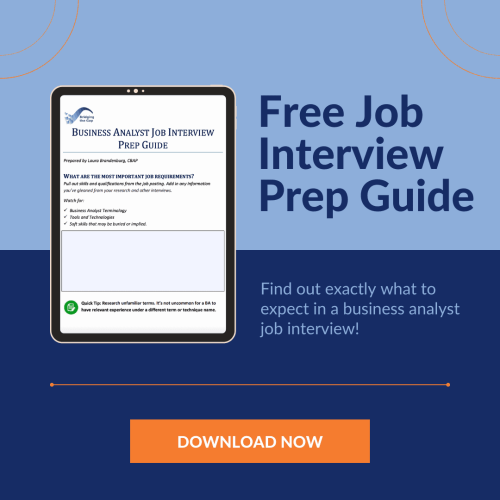An aspiring, career changer, or junior business analysts may seek to gain business analysis experience in today’s market by either volunteering, freelancing, educating themselves or seeking opportunities with their current employer.
Hopefully, with focus, persistence and taking the opportunities to gain some business analysis experience, the effort spent job hunting will pay off and you will get a business analyst interview.
It is important to prepare for a business analyst interview and this article guides you on how to answer any interview question very well.
Every job seeking business analyst should try and improve on and even master answering any scenario or behavioural question in an effective and professional way using the following helpful formula.
The insider’s guide to landing your dream business analyst job provides useful tips, guidance, and strategies to get your business analyst job.
provides useful tips, guidance, and strategies to get your business analyst job.
Answer Any Business Analyst Interview Question with This Easy 4 Step Formula
There is an easy formula to apply when you answer any scenario or behavioural based interview question during an interview. This formula allows you to stay focussed and cover all the most important aspects of any question by guiding yourself through it as you answer the interviewer.
Ultimately the interviewer wants to get to know you, your skills and experience and most importantly whether you will be able to solve their problem (or put another way, meet their needs for skills in a specific area). You are the business analyst introduce yourself as being confident and assertive.
They want to feel confident in your ability to meet their needs and it is you job during the interview to give them that confidence. Using this proven and highly effective strategy when answering questions will give the interviewer exactly what they are after: confidence in your ability to deliver.
The insider’s guide to landing your dream business analyst job shares the STAR formula
shares the STAR formula below:
below:
Once the interviewer poses their question, you answer the question following these guidelines.
Once the interviewer poses their question, you answer the question following these STAR formula guidelines.
S – Situation
You start by using a few sentences to describe the situation and brief background (if relevant) of a particular situation. I literally mean only 3-4 sentences to state what the situation was.
T – Task
You then describe to the interviewer what the task was that was given to you to execute in this situation. Again, be specific and clear about what it was you had to do.
A – Actions
This part of the answer is all about what and how you performed the execution of the assigned task. Focus on your specific actions (and not the group’s actions) and describe it using good, positive adjectives. This is your most important part of the answer, and you should therefore spend the most time on this part of your answer. Remember to say, “I did abc.” as opposed to “We did abc.”
Important: The interviewer is primarily interested in what you as an individual can do, not what you can do with others helping you.
R – Result
Always remember to have an outcome or result associated with what you specifically achieved. Again, you can mention the group’s result here too but put all the focus on the part of the outcome or result that you were specifically responsible for.
Example of how to implement the STAR for your job interview questions and answers follows below.
Answer using the STAR formula:
S – Situation
“I was working on an American Project for Company XYZ to implement a new finance system.”
T – Task
“I was responsible to prepare requirements plan for the entire project and had to ensure all stakeholder groups across America were included.”
A – Actions
“The way I went about preparing this plan was to start with understanding the number of stakeholders who would be involved in each country and
the timeframes I needed to work within.
This enabled me to define requirements gathering approach based on a geographically dispersed stakeholder group.
Requirements gathering were done via requirements validation sessions via country-by-country conference calls. Other parts of my plan included roles & responsibilities and̂ requirements documentation approach.”
R – Results
“I presented the requirements management plan to the project
management board and obtained sign off right away. My requirements management plan has since been re-used as a framework on other American initiatives.”
Note how brief I was in answering the first two aspects of the question, situation, and task.
This information is very important to set the scene but essentially not what the interviewer is after.
The actions part of the question is framed in terms of what I did specifically. Although it gives some detail, I am focusing on answering the most important aspects of this part of the question.
I am saying enough to cover off the answer well without going on and on about it. Finally, in the results part of the answer I focus on the main outcome of my actions, which is the re-use of my requirements management plan.
There may have been other outcomes too, but this is the most important.
Tip: Don’t give too much or too little detail during the job interview questions and answers, try and strike that good balance.
In general, spend about 2-3 minutes on answering any question unless it is a big question that the expectation is to elaborate. Remember that the interviewer can ask further questions if they want more detail about a particular aspect of your answer.
With focus and dedication the time spent in business job hunting will pay off and by following the tips in this article and by using the STAR formula you will have an advantage to get a business analyst job.
It is important to prepare for a business analyst interview and this article guides you on how to answer any interview question very well.
and this article guides you on how to answer any interview question very well.
The insider’s guide to landing your dream business analyst job provides useful tips, guidance, and strategies to get your business analyst job.
provides useful tips, guidance, and strategies to get your business analyst job.


